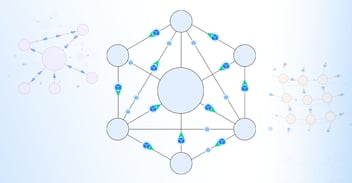Data mesh and data lakes are 2 of today’s hottest topics in data management. How do they differ, and how can they work together? Keep reading to find out.
Table of Contents
Data Mesh vs Data Lake: Defining the Next Generation of Data Management
What is a Data Lake?
What is Data Mesh??
Data Mesh vs Data Lake – How Are They Different?
Data Mesh vs. Data Lake – How They Work Together
A Data Product Platform Enables the Best of Both Worlds
Data Mesh vs Data Lake: Defining the Next Generation of Data Management
Modern businesses generate a wealth of data every day that is increasingly growing in volume.
Data consumers are eager to access this data to drive better business decisions, and personalize customer experiences. However, traditional data management infrastructures, like data warehouses, create bottlenecks and heighten reliance on data engineers and BI teams to meet the growing demand for operational insights, real-time decisioning, and analytics-driven predictions.
As a result, many companies are seeking new data management infrastructures that will enhance data access, improve decision making, and deliver business analytics at scale.
Data lakes, and more recently, data mesh, have emerged as effective data management strategies. Both address the need for superior data access, quality, consistency, and governance, while positioning organizations to deliver business insights at scale.
So, what’s the difference between data mesh and data lakes? Which one is better for you? Can they both be used together?
Keep reading to learn the answers to all three questions.
What is a Data Lake?
A data lake is defined as a centralized repository of data stored in the data’s natural, or “raw”, format.
Data lakes collect, organize, and protect large volumes of structured, semi-structured, unstructured, and binary data – including raw copies of source system data – in a single, often centralized, platform, typically in the cloud. 
Data lakes are the repositories of massive amounts of raw data.
Unlike data warehouses, which adhere to a schema-on-write approach, data lakes follow a schema-on-read approach. The key difference between these two approaches is that data lakes allow data to be structured at the time of query, according to a user’s needs – while data warehouses require that the data adheres to a predefined structure upon data ingestion.
What is Data Mesh?
Data mesh is an innovative data architecture for organizing and delivering enterprise data. It was developed out of the rising need to allow business domains to define, access, and control their own data products – with less reliance on centralized IT.
In a data mesh architecture, a dataset is integrated, processed, and managed by data products – to deliver clean, fresh, and complete data to any data consumer on demand, according to their permissions and roles.
Data mesh represents a decentralized architecture, in which data products are created and managed by different business domains in the company . Although the data mesh model adheres to distributed data governance (where each business domain governs its own data products), it relies on certain centralized data governance, security policies, and compliance standards.
Data Mesh vs Data Lake – How Are They Different?
There are 4 important differences between data mesh and data lakes:
-
-
Customer 360, where data is collected and organized from dozens of disparate source systems
-
Data Tokenization, where Personally Identifying Information (PII) is protected, with no risk of a mass breach.
-
Legacy Application Modernization, where legacy functionality and data is moved to the cloud, without affecting the business in any way
Data mesh supports operational use cases, while data lakes don’t
In a data mesh implementation, every business domain retains control over all aspects of its data products, for both analytical and operational use cases. Common examples of operational use cases include:
-
-
Data mesh is federated, while the data lake is a centralized data management design
Data mesh supports a data product approach, which stores all of the data associated with a specific business entity in its own encrypted Micro-Database™ (mDB). Governing and storing business entity data in mDBs, as opposed to dumping it, raw, into one central repository (like a data lake), lets an organization connect its business domains directly with the datasets they require. -
Data mesh enables self-service for data consumers, while data lakes depend on data engineers or data scientists
Data mesh allows authorized data consumers to discover, access and share data products with ease, shielding them from the data complexities inherent in underlying systems. Data lakes rely on data engineers, or data scientists, to prepare and provision the necessary data, which is often a time-consuming, repetitive, and error-prone process that extends the time to insights.
With data mesh, authorized data consumers can access their data all by themselves.
-
Data mesh supports federated data governance, while data lakes don’t
With data mesh, business domains have the authority to create and deliver their own data products, while adhering to centralized data governance rules. As a result, data mesh maximizes speed and agility. Data lakes require centralized data governance, which is often hard to apply to data originating from different source systems, and stored in different formats.
Data Mesh vs. Data Lake – How They Work Together
It’s clear that when compared side-by-side, data mesh better supports business domain success by empowering line-of-business users with self-service access to data for analytical and operational workloads. Mesh also ensures data continuity and prevents the silos that result from data “dumping” into centralized repositories.
However, data lakes and data mesh can still work together. Here’s how:
-
Data mesh can include data lakes
Whereas data lakes store large quantities of data in one physical location, data mesh integrates data from different data producers, into domain-specific data products. When an organization implements the data mesh framework on top of a data lake, the data lake, itself, serves as a data producer. -
Data mesh can operationalize insights from data lakes
Alone, a data lake does not support operational analytics. But with data mesh, you can ensure that insights from data lakes are operationalized into key business processes via Reverse ETL. -
Data mesh can move data securely into a centralized lake
Data mesh can securely pipeline data into a centralized lake. With data mesh-enabled data governance and cleansing, as well as proper data cataloging, the data lake can remain a productive, centralized store of data.
A Data Product Platform Enables the Best of Both Worlds
A Data Product Platform, deployed in a data mesh architecture, empowers organizations to more effectively manage, store, and operationalize the troves of data they collect every day.
It delivers a holistic and complete view of each business entity’s data, while ensuring data continuity across business domains.
When applied on top of a data lake, data mesh lends critical capabilities to centralized data, empowers business users to make better decisions, and enables data teams to focus on their core objectives.














